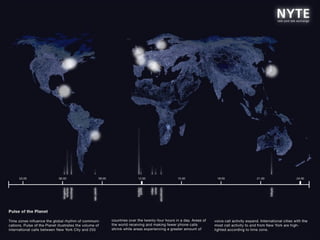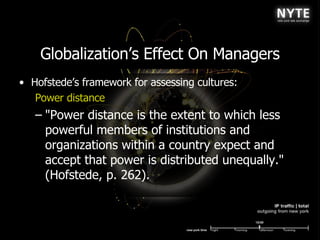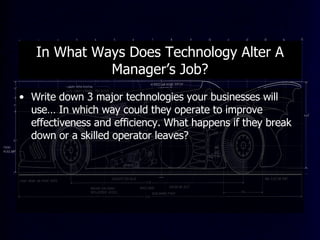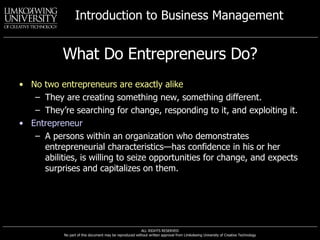Day2
- 1. 2 PART I: Introduction
- 2. Learning Outcomes After this class, I will be able to:
- 3. 1. Describe the three waves in modern social history and their implications for organizations.
- 4. 2. Explain the importance of viewing management from a global perspective .
- 5. 3. Identify the ways in which technology is changing the manager’s job.
- 6. 4. Describe the difference between an e- business, e- commerce, and an e- organization.
- 7. 5. Define social responsibility and ethics.
- 8. 6. Explain what is meant by the term entrepreneurship and identify the components of the entrepreneurial venture.
- 9. 7. Describe the management implications of a diversified workforce.
- 10. 8. Identify which work/life concepts are affecting employees.
- 11. 9. Explain why many corporations in the west have downsized .
- 12. 10. Describe the key variables for creating a customer-responsive culture.
- 13. 11. Explain why companies focus on quality and continuous improvement.
- 14. Agriculture Until the late nineteenth century, all economies were agrarian. The Changing Global Economy
- 15. Agriculture Agriculture continues to dominate the Cambodian economy, accounting for 43% of the country’s GDP and employing 75% of the labour force. The Changing Global Economy
- 16. The Changing Global Economy Industrialization From the late 1800s until the 1960s, most developed countries moved from agrarian societies to industrial societies.
- 17. The Changing Global Economy Industrialization There are now more than 250 garment factories operating in Cambodia. Better Factories Cambodia estimated that the number of garment enterprises rose by 13 last year. In 2005, Cambodia exported garments worth 2.17 billion dollars
- 18. The Changing Global Economy Information Information technology is transforming society from its manufacturing focus to one of service. More people, are going more places, more often than ever before.
- 19. The Changing Economy Exhibit 2.1 Old Economy Naional borders limit competition Technology reinforces rigid hierarchies and limits access to information Job opportunities are for blue-collar industrial workers Population is relatively homogeneous Business is estranged from its environment Economy is driven by large corporations Customers get what business chooses to give them New Economy National borders no longer define an organization’s operating boundaries Technological change makes information more accessible Job opportunities are for knowledge workers Population is characterized by cultural diversity Business accepts its social responsibilities Economy is driven by small entrepreneurial firms Customer needs drive business
- 20. The Changing Economy Exhibit 2.1 Old Economy Naional borders limit competition Technology reinforces rigid hierarchies and limits access to information Job opportunities are for blue-collar industrial workers Population is relatively homogeneous Business is estranged from its environment Economy is driven by large corporations Customers get what business chooses to give them New Economy National borders no longer define an organization’s operating boundaries Technological change makes information more accessible Job opportunities are for knowledge workers Population is characterized by cultural diversity Business accepts its social responsibilities Economy is driven by small entrepreneurial firms Customer needs drive business
- 21. The Changing Economy Exhibit 2.1 Old Economy Naional borders limit competition Technology reinforces rigid hierarchies and limits access to information Job opportunities are for blue-collar industrial workers Population is relatively homogeneous Business is estranged from its environment Economy is driven by large corporations Customers get what business chooses to give them New Economy National borders no longer define an organization’s operating boundaries Technological change makes information more accessible Job opportunities are for knowledge workers Population is characterized by cultural diversity Business accepts its social responsibilities Economy is driven by small entrepreneurial firms Customer needs drive business
- 22. The Changing Economy Exhibit 2.1 Old Economy National borders limit competition Technology reinforces rigid hierarchies and limits access to information Job opportunities are for blue-collar industrial workers Population is relatively homogeneous Business is estranged from its environment Economy is driven by large corporations Customers get what business chooses to give them New Economy National borders no longer define an organization’s operating boundaries Technological change makes information more accessible Job opportunities are for knowledge workers Population is characterized by cultural diversity Business accepts its social responsibilities Economy is driven by small entrepreneurial firms Customer needs drive business
- 23. A Global Marketplace Global village The concept of a boundaryless world; the production and marketing of goods and services worldwide.
- 24. A Global Marketplace Borderless organization A management structure in which internal arrangements that impose artificial geographic barriers are broken down
- 25. Global Competition Multinational corporations (MNCs) Companies that maintain significant operations in two or more countries simultaneously but are based in one home country. Transnational corporation (TNC) A company that maintains significant operations in more than one country simultaneously and decentralizes decision making in each operation to the local country. Strategic alliances A domestic firm and a foreign firm share the cost of developing products or building production facilities in a foreign country.
- 26. Stages of Going Global Exhibit 2.3
- 27. Globalization’s Effect On Managers Hofstede’s framework for assessing cultures: Power distance Individualism versus collectivism Quantity of life versus quality of life Uncertainty avoidance Long-term versus short-term orientation
- 28. Globalization’s Effect On Managers Hofstede’s framework for assessing cultures: Power distance "Power distance is the extent to which less powerful members of institutions and organizations within a country expect and accept that power is distributed unequally." (Hofstede, p. 262).
- 29. Globalization’s Effect On Managers Hofstede’s framework for assessing cultures: Power distance “ Power distance also describes the extent to which employees accept that superiors have more power than they have. Furthermore that opinions and decisions are right because of the higher position some has.”
- 30. Globalization’s Effect On Managers Hofstede’s framework for assessing cultures: Individualism versus collectivism “ Individualism is "the opposite of collectivism; together they form on of the dimensions of national cultures. Individualism stands for a society in which the ties between individuals are loose: everyone is expected to look after himself or herself and his or her immediate family only."
- 31. Globalization’s Effect On Managers Hofstede’s framework for assessing cultures: Quantity of life versus quality of life Quantity of life measures how much one prefers assertiveness, materialism, and competition; i.e. capitalistic self-interest. Quality of life measures how much one prefers relationships and empathy.
- 32. Globalization’s Effect On Managers Hofstede’s framework for assessing cultures: Uncertainty avoidance This reflects the extent to which members of a society attempt to cope with anxiety by minimizing uncertainty. Cultures that scored high in uncertainty avoidance prefer rules (e.g. about religion and food) and structured circumstances, and employees tend to remain longer with their present employer.
- 33. Globalization’s Effect On Managers Hofstede’s framework for assessing cultures: Long-term versus short-term orientation Long vs. short term orientation - describes a society's "time horizon," or the importance attached to the future versus the past and present.
- 34. Globalization’s Effect On Managers Parochialism A narrow focus in which one sees things solely through one’s own view and from one’s own perspective
- 35. Global Leadership and Organizational Behavior Effectiveness (GLOBE) An ongoing cross-cultural investigation of leadership and national culture Confirms and extends Hofstede’s earlier work on national cultural dimensions and leadership. Also found that the strength of cultural dimensions appear to be changing. Cultural Dimensions Assertiveness Future orientation Gender differentiation Uncertainty avoidance Power distance Individualism/Collectivism In-group collectivism Performance orientation Humane orientation
- 36. GLOBE Highlights Exhibit 2.4 Source: M. Javidan and R. J. House, “Cultural Acumen for the Global Manager: Lessons from Project GLOBE,” Organizational Dynamics , Spring 2001, pp. 289–305.
- 37. GLOBE Highlights Exhibit 2.4 (cont’d) Source: M. Javidan and R. J. House, “Cultural Acumen for the Global Manager: Lessons from Project GLOBE,” Organizational Dynamics , Spring 2001, pp. 289–305.
- 38. GLOBE Highlights Last week, in your groups, you picked out some example businesses. We described their differences. Now using Hofstede’s and Globe’s highlights describe how you would expect staff in the same businesses to behave if they were situated in Denmark, Vietnam, Argentina, Morocco, and the UK? How would these differences affect the way they do business?
- 39. Emphasis on Technology Technology Any equipment, tools, or operating methods that are designed to make work more efficient Information Technology (IT) Benefits of IT Cost savings (e.g., inventory control) Freedom from fixed locations for operations Challenges Increased worker skill requirements A leveling of the the competitive playing field that increases competition
- 40. Internet Business Terms E-commerce Any computer transaction that occurs when data are processed and transmitted over the Internet E-organization The applications of e-business concepts offered to stakeholders. E-business The full breadth of activities included in a successful Internet-based enterprise
- 41. What Defines an E-Business? Exhibit 2.5
- 42. In What Ways Does Technology Alter A Manager’s Job? Effectiveness and efficiency Managers have access to more complete and accurate information than before, enabling them to function as better managers. Place Telecommuting: the linking of a worker’s computer and modem with those of co-workers and management at an office.
- 43. In What Ways Does Technology Alter A Manager’s Job? Write down 3 major technologies your businesses will use… In which way could they operate to improve effectiveness and efficiency. What happens if they break down or a skilled operator leaves?
- 44. Society’s Expectations of Business Social responsibility A firm’s obligation, beyond that required by the law and economics, to pursue long-term goals that are beneficial to society. Social obligation The obligation of a business to meet its economic and legal responsibilities and no more. Social responsiveness The ability of a firm to adapt to changing societal conditions.
- 45. Society’s Expectations of Business
- 46. Arguments for Social Responsibility Exhibit 2.6 Public expectations Long-run profits Ethical obligation Public image Better environment Discouragement of further government regulation Balance of responsibility and power Stockholder interests Possession of resources Superiority of prevention over cures Source: Adapted from R. J. Monsen Jr., “The Social Attitudes of Management,” in J. M. McGuire, ed. Contemporary Management: Issues and Views (Upper Saddle River, NJ: Prentice Hall, 1974), p. 616: and K. Davis and W. Frederick, Business and Society: Management, Public Policy, Ethics , 5th ed. (New York: McGraw-Hill, 1984), pp. 28–41.
- 47. Arguments against Social Responsibility Exhibit 2.6 (cont’d) Violation of profit maximization Dilution of purpose Costs Too much power Lack of skills Lack of accountability Lack of broad public support Source: Adapted from R. J. Monsen Jr., “The Social Attitudes of Management,” in J. M. McGuire, ed. Contemporary Management: Issues and Views (Upper Saddle River, NJ: Prentice Hall, 1974), p. 616: and K. Davis and W. Frederick, Business and Society: Management, Public Policy, Ethics , 5th ed. (New York : McGraw-Hill, 1984), pp. 28–41.
- 48. Ethics and Business Ethics A set of rules or principles that defines right and wrong conduct Code of ethics A formal document that states an organization’s primary values and the ethical rules it expects managers and operatives to follow
- 49. Three Views of Ethics Exhibit 2.7 Utilitarian view of ethics Making decisions solely on the basis of their outcomes or consequences. Rights view of ethics Respecting and protecting individual liberties and privileges Theory of justice view of ethics Fairly and impartially imposing and enforcing rules. Source: G. F. Cavanaugh, D. J. Moberg, and M. Valasquez, “The Ethics of Organizational Politics.” Academy of Management Journal (June 1981): 363–74 .
- 50. What Is Entrepreneurship? Entrepreneurship The process of initiating a business venture, organizing the necessary resources, and assuming the risks and rewards Steps in the entrepreneurial process Exploring the entrepreneurial context. Identifying opportunities and competitive advantages Starting the venture. Managing the venture
- 51. What Do Entrepreneurs Do? No two entrepreneurs are exactly alike They are creating something new, something different. They’re searching for change, responding to it, and exploiting it. Entrepreneur A persons within an organization who demonstrates entrepreneurial characteristics—has confidence in his or her abilities, is willing to seize opportunities for change, and expects surprises and capitalizes on them.
- 52. Diversity and the Workforce of 2010 Increasing workforce diversity More variation in the background of organizational members in terms of gender, race, age, sexual orientation, and ethnicity Characteristics of the future workforce More heterogeneous/diverse Increasingly older More multicultural Diversity will require more managerial sensitivity to individual differences.
- 54. Mars Incorporated Diversity Philosophy Exhibit 2.8 “ Distinctive voices working together within a common culture” is one of the ways we have described how we do business at Mars. We believe that the success of our business can be enhanced by having a workforce made up of associates from many different backgrounds, much as our society and consumer base consist of a wide variety of individuals. We value the talents and contributions of our diverse workforce in reaching toward our future and in playing responsible leadership roles. Source: www.mars.com/other_policies/diversity.as
- 55. Labor Supply and Demand Adjustments Downsizing An activity in an organization designed to create a more efficient operation through extensive layoffs Rightsizing Linking staffing levels to organizational goals Outsourcing An organization’s use of outside firms for providing necessary products and services
- 56. Flexible Workforces Core employees The small group of full-time employees of an organization who provide some essential job tasks for the organization Contingent workforce Part-time, temporary, and contract workers who are available for hire on an as-needed basis
- 57. Contingent Workers Exhibit 2.9 Part-time employees Work fewer than 40 hours a week Are a good source of staffing for peak hours. May be involved in job sharing Temporary employees Are generally employed during peak periods Can fill in for employees for an extended period of time Create a fixed labor cost during a specified period Contract workers Are hired by organizations to work on specific projects. Are paid when the firm receives particular deliverables. Are a labor cost that is fixed by contract
- 58. Making a Company’s Culture More Customer-responsive Actions that create employees with the competence, ability, and willingness to solve customer problems as they arise: Selection: hiring the right personalities and attitudes Training: developing the customer-focus employees Organizing: creating customer-friendly controls Empowerment: independence in relating to customers Leadership: commitment to the customer-focus vision Evaluation: performance measured by behaviors Rewards: contingent on outstanding customer service
- 59. Shaping a Customer-Responsive Culture Exhibit 2.10
- 60. Increased Concern for Quality Continuous improvement Organizational commitment to constantly improving the quality of a product or service Joseph Juran W. Edwards Deming Kaizen: the Japanese term for an organization committed to continuous improvement Work process engineering Radical or quantum change in an organization
- 61. Components of Continuous Improvement Exhibit 2.11 Intense focus on the customer . Concern for continuous improvement . Improvement in the quality of everything the organization does. Accurate measurement . Empowerment of employees .





























































